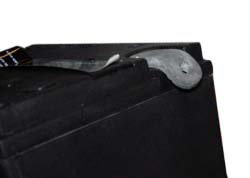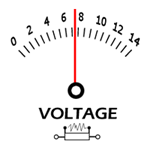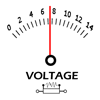How to Tell if Your Battery Is Bad in 3 Easy Steps
Have battery troubles? Yeah, we hear you. Almost every day, we receive calls and comments about batteries that "won't hold a charge." Maybe you've been in that boat before.
To clear up a misconception, a battery isn't like a water bottle. You can't use up half now, wait, and use half later. It's not a tank of electricity. Also, batteries don't "leak" power like water can.
What we're dealing with is a lead-based or lithium battery in a plastic box that encases a delicate balance of chemicals ready to interact with each other to produce electricity when the load is applied.
If your battery is having trouble holding under load, then chances are it's a chemical issue.
How to test a battery:
Here are some ways to test your battery at home, and determine if it's bad:
1) Inspect the Battery
 Sometimes, you can tell if your battery is bad by simply taking a good look. There are a few things to inspect:
Sometimes, you can tell if your battery is bad by simply taking a good look. There are a few things to inspect:
- Broken terminal
- Bulge or bump in the case
- Crack or rupture of the plastic
- Excessive leaking
- Discoloration
Broken or loose terminals are dangerous and can cause a short circuit. If a short did occur, there would be some indication of burning or melting. When a battery short circuits, all the power is instantly unloaded. That produces a lot of heat, and while it rarely happens, it can cause the battery to explode.
If the battery is still intact but there is a bulge in the case, this is usually a result of being overcharged. Other signs, such as physical openings in the case, are often caused by mishandling. Cracks, splits, and holes will not cause a battery to stop working, but the battery should be labeled unsafe for safety reasons.
With wet-cell (flooded) batteries, water levels must be maintained. If they are low, usually refilling them with distilled water will help. But, if the cells within the battery have been exposed to air for a long time, it can cause a problem.
When the plates within each cell are exposed to oxygen, the paste surrounding the lead plates can dry. When the paste has dried, it creates a barrier that prevents the chemical reaction within the battery. This can also cause the sulfation that has already occurred to harden, leading to a sulfated battery, the number one cause of early battery failure.
We strongly recommend checking the water levels before charging a wet cell battery since charging a dry battery will burn it up. If your battery has plenty of fluid in the cells, but the color is dark or brownish, this is also an indication of a bad battery. Even if one cell is brown, it is rendered useless; therefore, the entire battery is also. Time to replace your battery!
2) Take a Voltage Reading
The voltage of a battery is an excellent way to determine the state of charge. Here's a handy table with the breakdown:
| State of Charge | Voltage |
| 100% | 12.7 - 13.2 |
| 75% | 12.4 |
| 50% | 12.1 |
| 25% | 11.7 |
| Discharged | 0 - 11.6 |
If your battery is:
- Reading 0 volts, chances are the battery experienced a short circuit
- Cannot reach higher than 10.5 volts when being charged, then the battery has a dead cell
- Fully charged (according to the battery charger) but the voltage is 12.4 or less, the battery is sulfated
In lead acid batteries, sulfation is the natural byproduct that occurs when a battery discharges. And, when you are re-charging the battery, the sulfation process reverses and dissolves the sulfation crystals, turning them back into electrolytes, ready to produce power again.
However, if a battery sits uncharged, severely discharged, and/or drained for extended periods, the sulfation will increase within the battery and harden onto the lead plates. This covers the surface area of the plates, removing the chemicals needed to produce power.
When a battery is sulfated, it decreases the battery’s potential to reach a full charge, and it can cause it to self-discharge quicker than normal. Charging a sulfated battery is like trying to wash your hands while wearing gloves.
At this point, charging alone will not restore the battery to a healthy condition. Most replacement battery purchases occur when the original battery has reached this point.
It is important to note that technologies exist to slow the sulfation process and even reverse it in certain circumstances. In the end, a flooded, AGM, gel, or sealed lead acid battery will die from sulfation, but desulfation chargers and chemicals can help to prolong battery life.
3) Load Test the Battery
Your local automotive shop can load test your battery, but it's pretty easy to do at home, and all you need is a digital voltmeter. For any load test to be accurate, the battery must be fully charged and left to sit for 12 hours before load testing the battery.
A recently charged battery will hold a residual charge from the charger, so letting the battery sit for 12 hours will release that residual charge and give you a more accurate sense of how the battery will perform under normal circumstances. To the test...
Let's use a motorcycle battery for an example:
- Remove the seat and expose the battery in your bike so that you have access to the terminals. Do not disconnect the battery because you will attempt to start the bike.
- Hold the prongs of your voltmeter to the correct terminals on the battery.
- Now push the start button and watch what the voltage drops to. It doesn't matter if the bike starts or not, what you're looking for is a voltage reading.
A healthy 12-volt battery should maintain a voltage range from 9.6 - 10.5+ volts under the load for 30 seconds straight.
We don't expect you to run the starter for 30 seconds for starting batteries, so if you see the voltage meter drop within the voltage range and it sounded like a good strong start, then you probably just had a discharged battery. However, if under the starting load, the voltage drops below 9.6v, then it is most likely time to replace the battery.
For deep cycle applications, if the battery holds under load for a few seconds, then voltage starts to drop steadily; this would indicate a problem with the battery.
If the voltage instantly drops to 0 volts, that is also a problem. We call this the open cell. On a new battery, this can result from manufacturing flaws or can also be caused by sulfate crystal buildup.

A common occurrence with open-cell batteries is that the initial voltage looks good, but under the intense heat of the load, one or more of the weld pieces connecting the cells separate.
This will cut the current, and the voltage will drop. When the battery cools off, the pieces will touch, barely giving a complete connection. This gives you a false voltage reading. Batteries with open cells may read fully charged, but they fail under a load test every time. Once a battery reaches this point, there is no fix. The best thing to do is recycle it.
Final Thoughts
We covered how to tell if a battery is bad or good. These 3 simple steps will help you test and determine if your battery is truly bad or getting there. Sometimes it's obvious if there is a failure, but other times it's not.
Flooded batteries make it possible to simply look inside the cells and determine if the battery has a physical defect. But for sealed AGM, gel, and lithium batteries it requires testing. The only tools you really need are a battery charger and a digital voltmeter. If your battery experiences any of the symptoms described in the steps above, then maybe it's time to replace the battery.
Look no further. We've got a wide selection of powersports batteries for your motorcycle, ATV, scooter, jet ski, or snowmobile. But we also carry batteries for lawn mowers, wheelchairs / mobility scooters, UPS systems, RVs, and marine applications. Whether you need a starting battery or a deep cycle battery, we have the stuff. And all of our replacement batteries come with warranties to ensure that you won't have any of these problems with your new battery.



